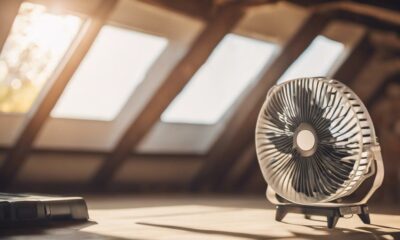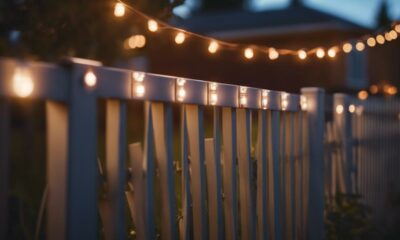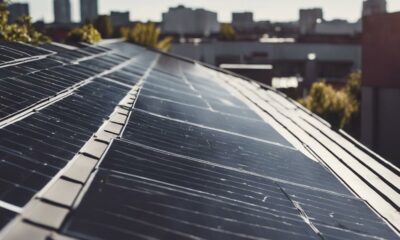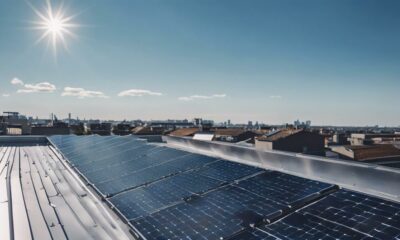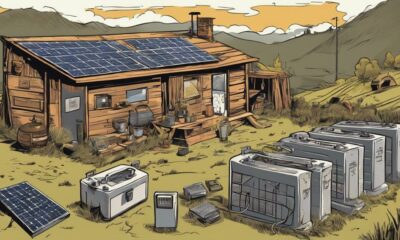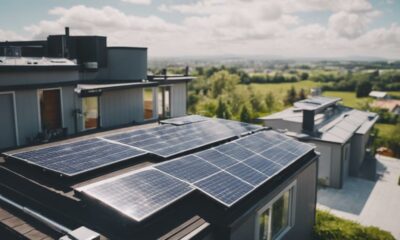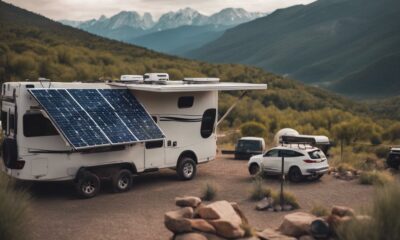Green Living
Green Revolution: Harnessing Wind for Power
Discover how wind turbines are revolutionizing the renewable energy landscape, but what's holding them back from reaching their full potential?
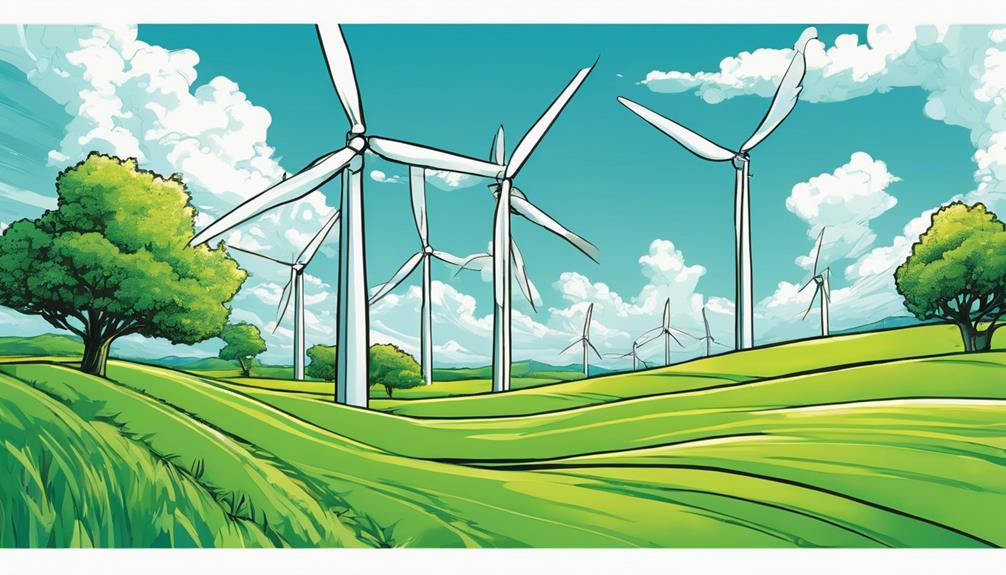
As the world shifts towards a more sustainable future, wind power is emerging as an essential component of the green revolution. Wind turbines can generate enough electricity to power over 15 million homes in the United States alone. By designing wind turbine systems with larger blades and higher towers, and optimizing their placement, more energy can be captured. Regular maintenance is key to ensuring peak performance, and while installation costs vary, wind turbines offer a cost-effective renewable energy source. With benefits ranging from environmental to economic and social, wind energy is poised to play a major role in the green revolution – and there's more to explore on this frontier.
Key Takeaways
- Larger wind turbine blades and higher towers capture more energy, increasing overall power output and efficiency.
- Proper turbine spacing and placement on highest points maximize wind capture and energy production.
- Regular maintenance is crucial to ensure peak performance, as neglecting it can lead to reduced energy production.
- Wind turbines offer a cost-effective, environmentally friendly energy source, reducing reliance on traditional sources and pollution.
- Thorough environmental impact assessments minimize ecological footprint, ensuring harmony with local ecosystems and clean energy sources.
Designing Wind Turbine Systems
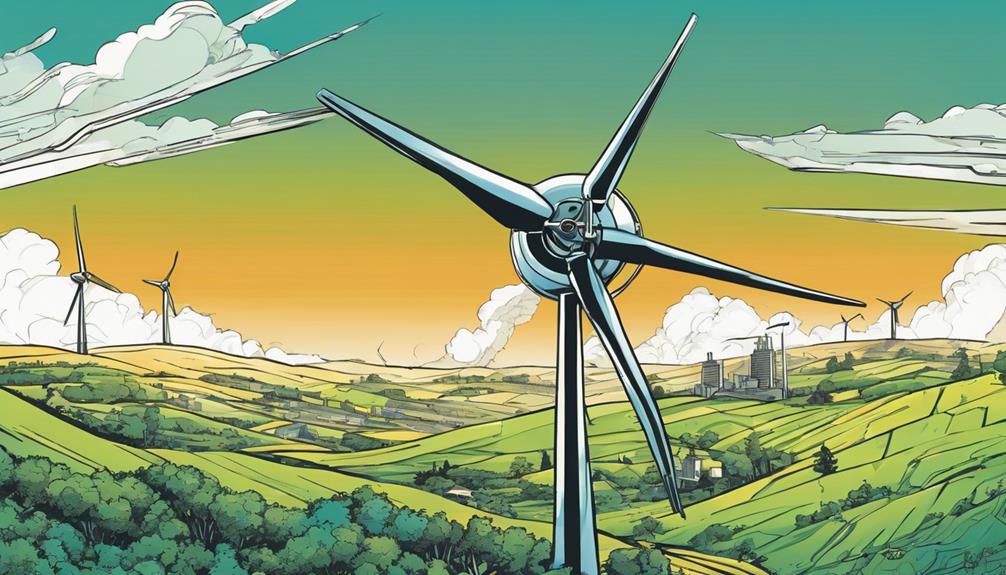
What makes a wind turbine system efficient, and how can its design be optimized to harness the maximum amount of wind energy?
The answer lies in the careful consideration of several key factors. Larger blades and higher towers capture more energy, while proper spacing between turbines optimizes wind capture.
Horizontal-axis turbines rely on prevailing winds, making them a popular choice. Wind turbine gardens, which come in various sizes and power outputs, can notably reduce reliance on utility electricity.
To maximize energy production, turbines should be installed at the highest point on the property, complying with height and distance regulations. By carefully designing and installing wind turbine systems, individuals can tap into a clean and abundant source of energy.
Maintenance and Cost Factors
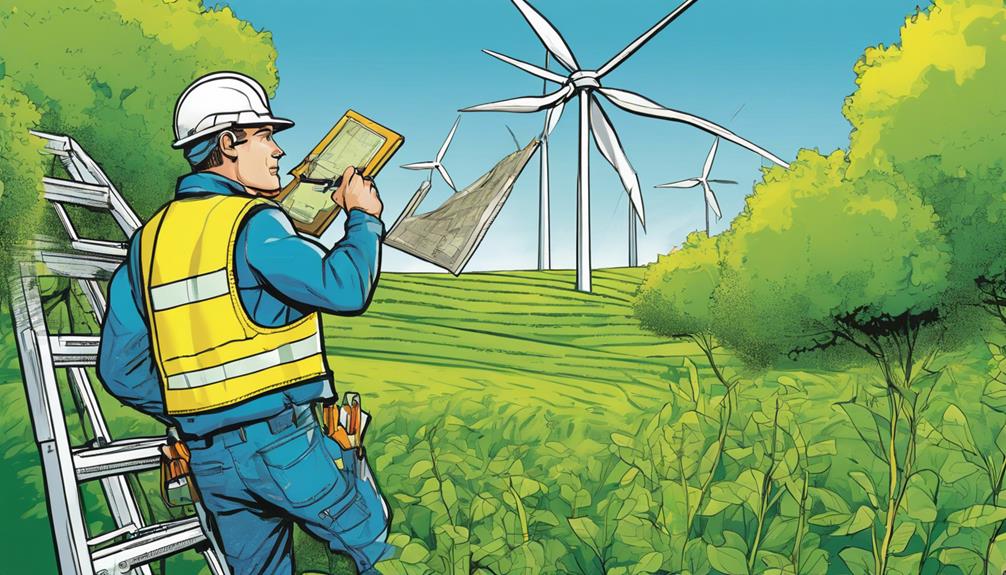
Regular examination and maintenance are critical components of wind turbine upkeep. They ensure peak performance and extend the turbine's lifespan. Focusing on critical components like the gearbox, blades, and bearings is essential. Neglecting maintenance can lead to reduced energy production, increased repair costs, and even turbine failure.
Installation costs vary widely, ranging from $500 to tens of thousands of dollars, depending on the type, size, and power output of the turbine. Larger systems require a team of workers for installation, and maintenance costs should be factored in for best performance.
Despite these costs, wind turbines offer a cost-effective renewable energy source. They can reduce or eliminate monthly electricity bills and provide a sustainable alternative to traditional energy sources.
Benefits of Wind Energy
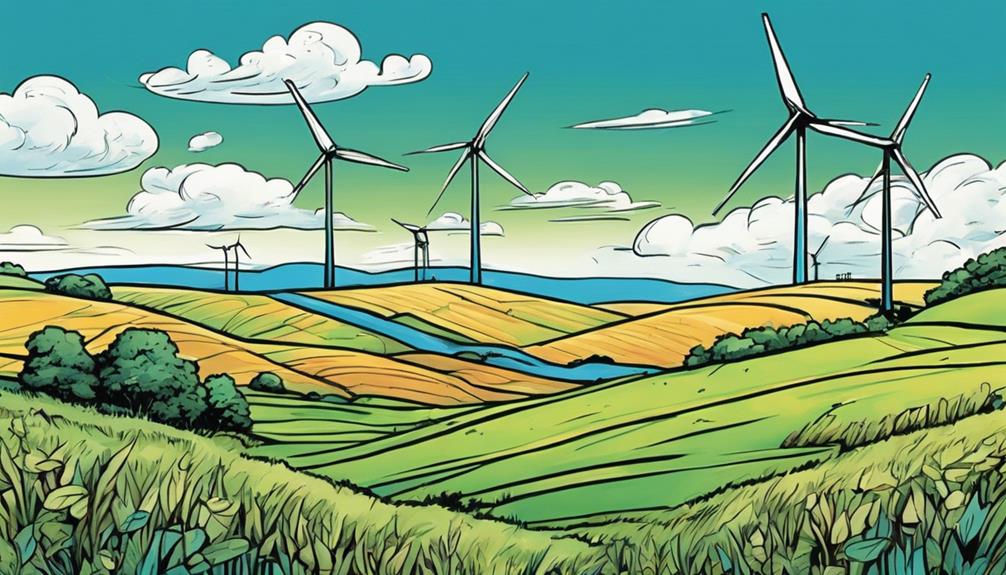
Wind turbines offer a multitude of benefits, ranging from environmental advantages to economic and social impacts, making them an attractive investment for individuals and communities seeking a sustainable energy future. They provide environmentally friendly energy, reducing reliance on traditional sources and minimizing air and water pollution.
Wind turbines also add value to homes, increasing their green credentials and combining efficiently with solar systems. Economically, they create jobs in the renewable energy sector, boost local economies, and lower electricity costs for consumers. Socially, they promote community resilience to energy crises, energy independence, and community engagement in sustainable practices.
Blade Configuration Essentials
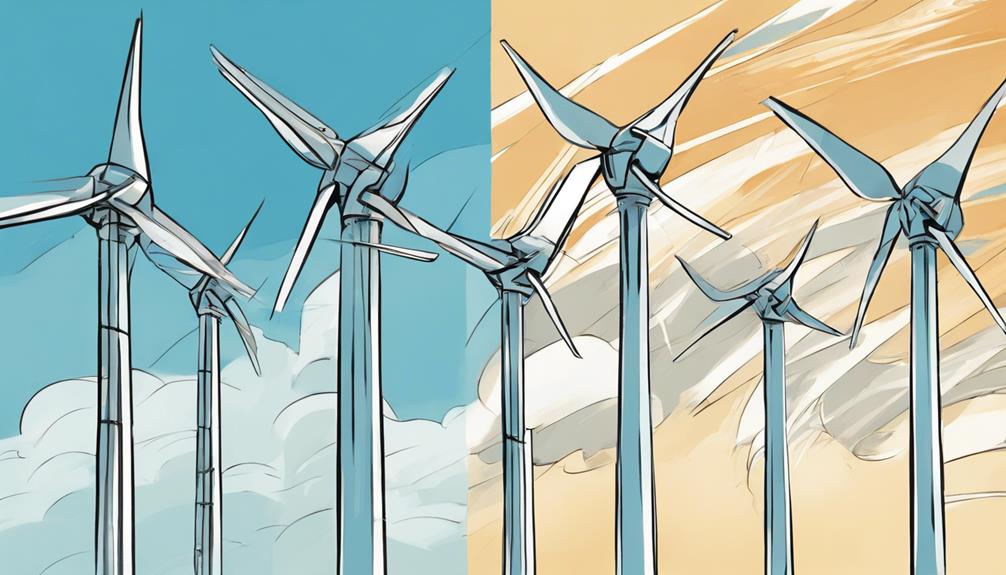
Optimizing blade configuration is essential for maximizing wind energy efficiency, as it directly impacts turbine performance and energy production. The right blade configuration can make a significant difference in harnessing wind power.
Several factors influence the choice of blade configuration, including wind conditions, budget, and environmental considerations.
- Two-blade turbines are cost-effective for low wind speeds, offering a simpler and more affordable design.
- Three-blade turbines provide efficiency and noise reduction benefits, making them a popular choice for residential areas.
- Five-blade turbines offer increased torque at lower rotational speeds, better resistance against strong gusts of wind, and improved efficiency in harnessing clean energy.
Environmental Impact Assessment
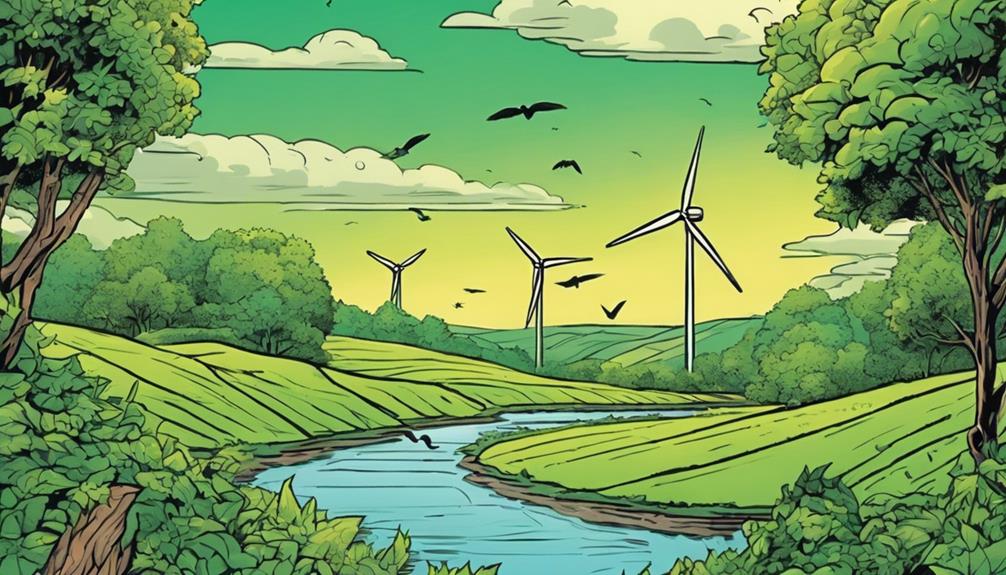
Every wind turbine installation requires a thorough environmental impact assessment to minimize its ecological footprint and ensure sustainable energy production. This assessment evaluates the potential effects of wind turbines on local ecosystems, including noise pollution, visual impact, and wildlife habitats. A detailed evaluation guarantees that wind turbines are installed in harmony with the environment, mitigating any negative consequences.
| Environmental Aspect | Impact | Mitigation Strategy |
|---|---|---|
| Noise Pollution | Increased noise levels | Soundproofing materials, strategic placement |
| Visual Impact | Altered landscape aesthetics | Camouflage design, community engagement |
| Wildlife Habitats | Disruption of natural habitats | Wildlife corridors, habitat restoration |
| Air Quality | Improved air quality | Reduced emissions, cleaner energy source |
| Water Pollution | No significant impact | None required |
Wind Turbine Installation Guide

After ensuring a comprehensive environmental impact assessment, property owners can proceed with installing wind turbines, which demands meticulous planning and execution to maximize energy production and minimize potential drawbacks. Proper installation is essential to harness the full potential of wind energy.
- Optimize turbine placement: Install turbines at the highest point on the property, following height and distance regulations, to capture prevailing winds and reduce interference.
- Choose the appropriate turbine size: Select a turbine that matches the property's wind conditions and energy needs, guaranteeing efficient energy production and minimizing visual impact.
- Consider maintenance and costs: Factor in maintenance costs and installation time, which vary depending on turbine type and size, to ensure a cost-efficient and sustainable energy solution.
Optimizing Energy Efficiency
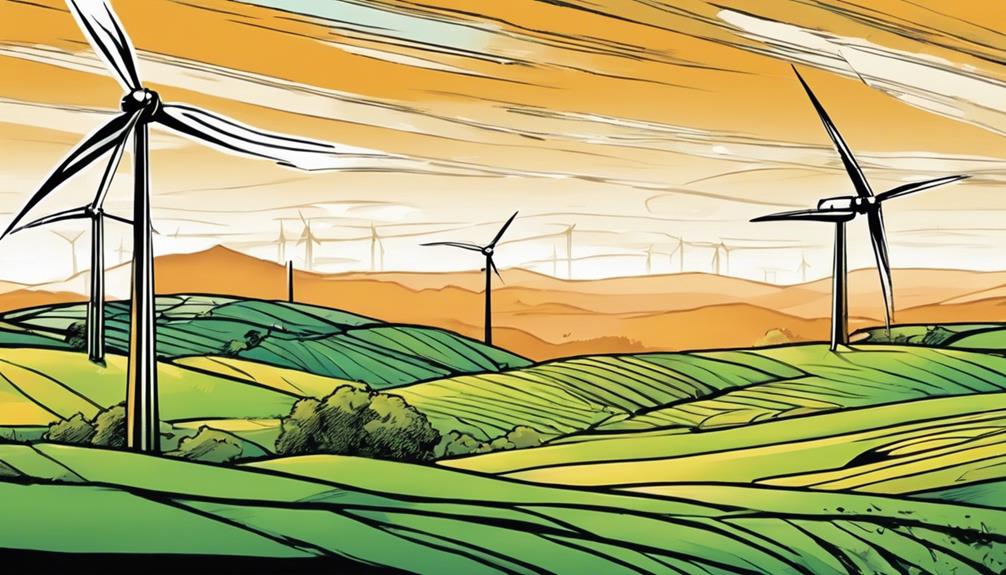
Wind turbine performance relies heavily on precise blade configuration, as the right design can greatly enhance energy efficiency and overall power output. The number of blades, their shape, and angle of attack all impact turbine efficiency. For instance, two-blade turbines are cost-effective for low wind speeds, while three-blade turbines offer efficiency and noise reduction benefits.
| Blade Configuration | Advantages | Disadvantages |
|---|---|---|
| 2-Blade | Cost-effective, low wind speed | Lower efficiency, higher noise |
| 3-Blade | Efficient, noise reduction | Higher cost, complex design |
| 5-Blade | High torque, wind resistance | Higher cost, complex maintenance |
Frequently Asked Questions
Can Wind Turbines Be Used in Urban Areas With High-Rise Buildings?
She notes that wind turbines can be used in urban areas with high-rise buildings, but their effectiveness depends on factors like wind speed, direction, and turbulence, requiring careful placement and design.
How Do Wind Turbines Affect Bird Migration Patterns and Habitats?
Wind turbines can impact bird migration patterns and habitats, particularly if installed near key migration routes or habitats, but proper placement and design can minimize these effects, ensuring a balance between renewable energy and conservation.
Are Wind Turbines Compatible With Existing Agricultural Practices?
Wind turbines can coexist with agricultural practices, as they occupy minimal land and can be installed around existing farms, allowing farmers to maintain their operations while generating renewable energy.
Can Wind Turbines Be Used to Power Electric Vehicles Directly?
Like a conductor leading an orchestra, wind turbines can harmoniously power electric vehicles directly, leveraging their clean energy to fuel a sustainable transportation revolution, making every mile a breeze.
Do Wind Turbines Produce Any Hazardous Waste During Operation?
She notes that wind turbines do not produce hazardous waste during operation, as they generate clean energy without burning fossil fuels or emitting pollutants, making them an environmentally friendly option.
How Can Wind Power Contribute to Electric Bike Escapades in the Green Revolution?
Wind power is a key player in the green revolution, offering a sustainable energy source for thrilling electric bike escapades. By harnessing the power of the wind, electric bikes can be charged using clean energy, reducing environmental impact and contributing to a more sustainable future for outdoor adventures.
Conclusion
As the wind turbine blades spin, a new era of sustainable energy takes flight. The green revolution is gaining momentum, sweeping away fossil fuels and ushering in a cleaner, healthier environment.
With each turbine installation, the world inches closer to a brighter future, where energy independence and environmental stewardship go hand in hand.
The winds of change are blowing strong, and it's time to harness them.
Green Living
12V LED Flood Lights: Brighten up Your Outdoor Space With Energy Efficiency!
Brighten your outdoor space with energy-efficient 12V LED flood lights that last longer and consume less power, but how do you choose the right ones?
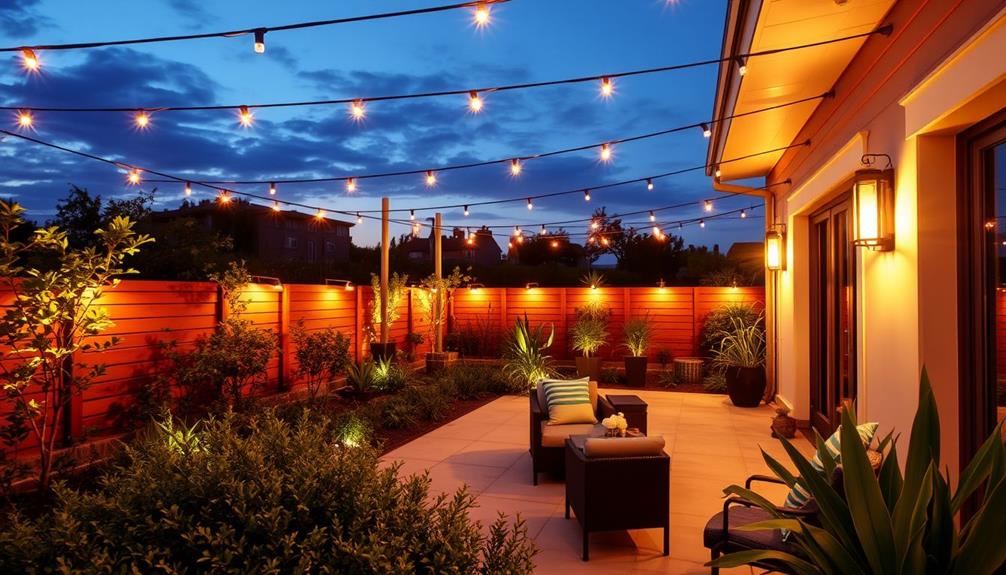
If you're looking to brighten up your outdoor space while saving energy, 12V LED flood lights are a fantastic choice. They consume up to 80% less power than traditional halogen lights and last between 30,000 to 50,000 hours, which means less hassle with replacements. With impressive brightness, they provide even illumination and can enhance both security and aesthetics. Plus, their weather-resistant design guarantees durability in all conditions. Whether you need landscape, architectural, or security lighting, there's a variety to fit your needs. Stick around to discover how to choose and install the perfect lights for your outdoor area!
Key Takeaways
- 12V LED flood lights offer impressive brightness, achieving up to 140 lumens per watt for effective outdoor illumination.
- They consume up to 80% less energy than traditional halogen lights, significantly lowering electricity costs.
- With a long lifespan of 30,000 to 50,000 hours, LED flood lights reduce replacement frequency and waste.
- The weather-resistant IP65 rating ensures durability and performance in various outdoor conditions.
- Versatile installation options enhance security and aesthetics without complicated wiring, making them ideal for any outdoor space.
Understanding 12V LED Flood Lights
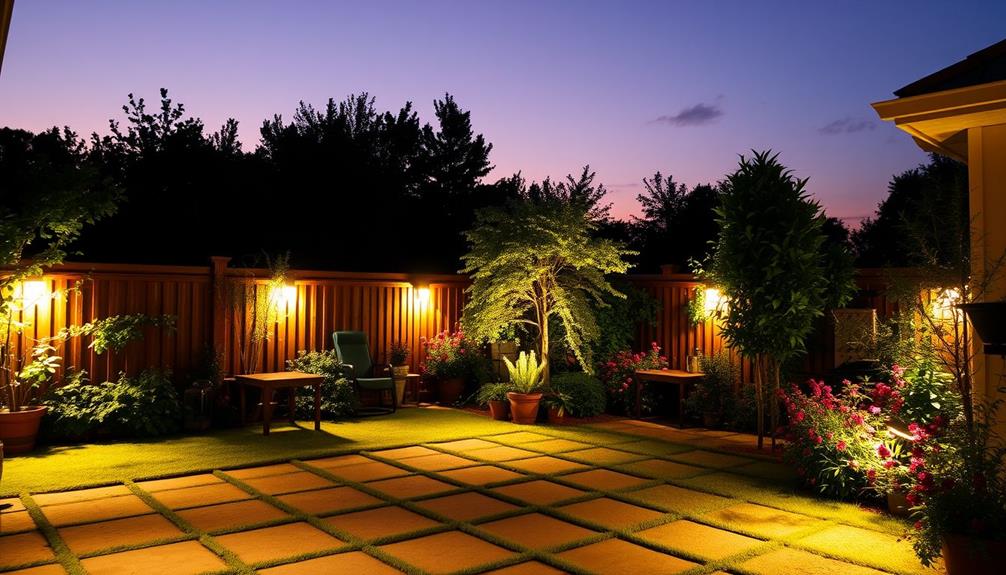
When considering outdoor lighting, understanding 12V LED flood lights can transform your space efficiently and effectively. These lights operate on a low voltage system, making them perfect for residential applications like gardens and landscapes.
One of the standout features of 12V LED flood lights is their energy efficiency; they consume considerably less energy than traditional halogen options, leading to lower electricity bills and a reduced environmental footprint. Additionally, such energy-efficient solutions can contribute positively to your overall financial health by saving you money in the long run.
You'll appreciate the long lifespan of these lights, which typically lasts between 30,000 to 50,000 hours. This means fewer replacements and lower maintenance costs for you.
Despite their lower wattage, 12V LED flood lights deliver impressive brightness and lumens, providing bright and even illumination for your outdoor spaces.
Another advantage is their installation versatility. You can easily incorporate these lights into various outdoor settings, enhancing both security and aesthetics without the hassle of complex wiring.
Benefits of 12V LED Flood Lights
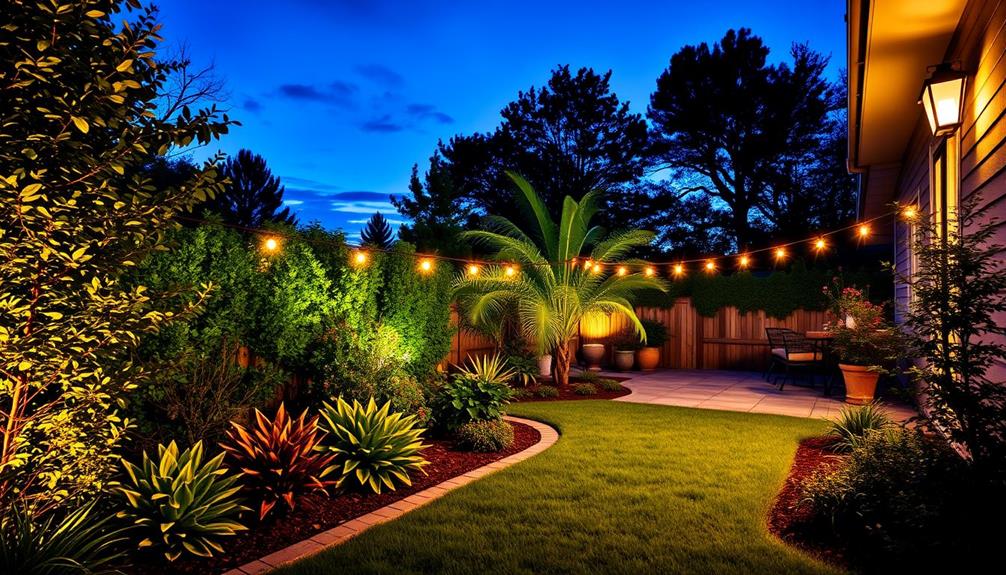
12V LED flood lights offer a multitude of benefits that make them a smart choice for outdoor lighting. One of the most significant advantages is their energy-efficient design, which can save you up to 80% on power consumption compared to traditional lighting. This translates to lower electricity bills, allowing you to light up your outdoor space without breaking the bank.
Additionally, using energy-efficient lighting options can contribute to a more sustainable living environment, aligning with the growing awareness of ethical sourcing and community support in various consumer products.
Moreover, 12V LED flood lights boast an impressive lifespan of 30,000 to 50,000 hours, meaning you won't have to worry about frequent replacements. This longevity reduces waste and maintenance costs, making them an environmentally friendly option. They provide bright, even illumination, enhancing visibility and safety in areas like gardens, pathways, and security zones.
Designed for outdoor use, many 12V LED flood lights come with weather-resistant features, including an IP65 waterproof rating, ensuring durability in various conditions.
Plus, their easy installation makes them perfect for low-voltage systems, allowing you to enhance your landscape lighting effortlessly. With these benefits, 12V LED flood lights are a practical and stylish addition to any outdoor setting.
Types of 12V LED Flood Lights

Several types of 12V LED flood lights cater to different outdoor lighting needs, making it easy to find the right fit for your space.
These lights aren't only energy-efficient but also offer remarkable durability and weather resistance, ensuring they're perfect for various applications.
For instance, choosing the right type of lighting can enhance your outdoor aesthetics, similar to how the role of color accuracy affects image quality in home cinema projectors.
Here are some types you might consider:
- Landscape Flood Lights: Ideal for illuminating gardens and pathways, enhancing your outdoor aesthetics.
- Architectural Flood Lights: Perfect for accentuating building features, showcasing your home's beauty at night.
- Security Flood Lights: Provide bright illumination to deter intruders and enhance safety around your property.
- Spot Flood Lights: These versatile lights can focus on specific areas, making them great for highlighting particular features.
- Portable Flood Lights: Easy to move around, perfect for temporary outdoor events or activities.
With 12V LED flood lights, you enjoy lower energy consumption, saving up to 80% compared to traditional options.
Plus, their impressive durability and lifespan (30,000 to 50,000 hours) mean less frequent replacements, contributing to lower maintenance costs.
Choosing the Right 12V LED Flood Light
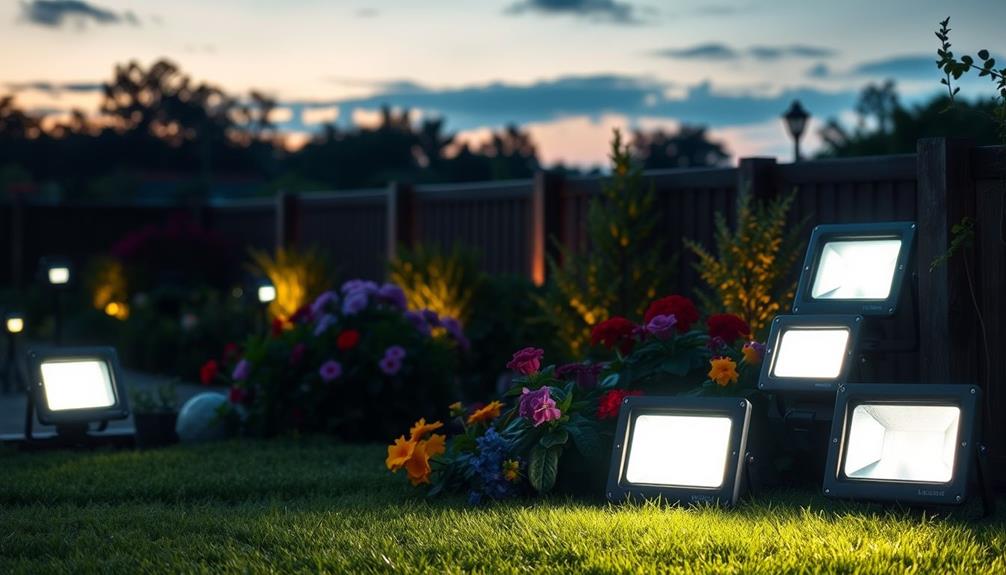
Selecting the right 12V LED flood light can greatly impact your outdoor lighting experience. When choosing one, pay close attention to the brightness measured in lumens. For effective outdoor illumination, aim for at least 1,500 to 2,000 lumens based on the size of your area and its intended use. Incorporating effective mood boards essential for visualizing design concepts can help you envision how different lighting options will enhance your outdoor space.
Energy efficiency is another key factor. A 12V LED flood light typically consumes between 15W to 50W, offering significant energy savings compared to traditional lighting options. Opt for models with adjustable wattage settings, such as 15W, 30W, or 50W, so you can tailor the brightness to your specific needs while minimizing energy consumption.
Don't forget about the flood light's waterproof rating. Look for an IP65 rating to guarantee durability against harsh weather conditions, enhancing the longevity of your investment.
Installation Guide for 12V LED Flood Lights
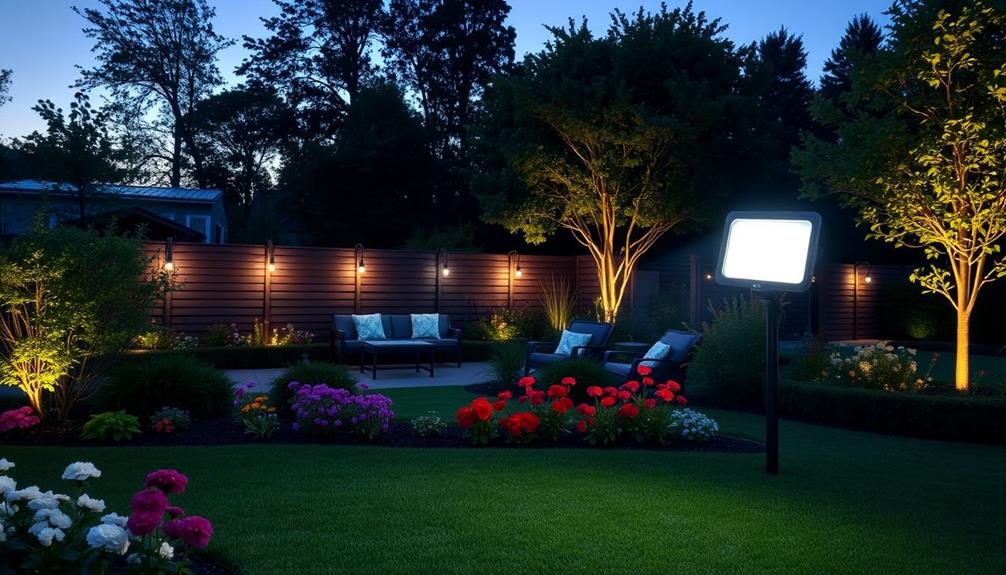
When you're ready to install your LED flood lights, it's vital to start by turning off the power supply to guarantee safety.
This installation guide will help you set up your 12V LED flood lights for peak performance in your outdoor space. Proper installation practices are fundamental, as they can prevent operational problems and guarantee your lighting system functions efficiently for years to come, much like the benefits of advanced technology in heating systems.
Here are some key steps to follow:
- Gather Necessary Tools: You'll need a voltage tester, wire connectors, and mounting brackets.
- Choose the Right Location: Position the flood lights for peak coverage and confirm they're free from obstructions.
- Connect to Transformer: Use a compatible transformer to convert standard voltage to 12V, adhering to proper wattage ratings.
- Use Weatherproof Connectors: Secure all electrical connections with weatherproof wire connectors to protect against the elements.
- Check for Waterproof Rating: Verify your flood lights have an IP65 waterproof rating for outdoor durability.
Maintenance Tips for 12V LED Flood Lights

To keep your 12V LED flood lights shining bright, you should establish a regular cleaning schedule to remove dirt and debris.
Additionally, considering the benefits of enhanced security, installing flood lights can deter potential intruders as they illuminate your outdoor space, creating a safer environment for your home, which aligns with the value of home security systems.
It's also important to check connections periodically for any wear or corrosion that could cause issues.
Regular Cleaning Schedule
Maintaining your 12V LED flood lights is essential for ensuring they perform at their best. Regular cleaning not only enhances efficiency but also prolongs the lifespan of your lights.
Energy-efficient appliances, like LED flood lights, can contribute greatly to reducing overall energy consumption in your home, making regular upkeep even more worthwhile energy efficiency benefits. Aim to clean them every six months to prevent dirt and debris from accumulating, which can reduce light output.
Here are some tips to keep your LED flood lights shining bright:
- Turn off and allow the lights to cool down before cleaning.
- Use a soft cloth and a mild detergent solution to gently wipe the exterior.
- Avoid abrasive materials that could scratch the lens.
- Inspect seals and gaskets for wear or damage to prevent moisture ingress.
- Schedule a thorough maintenance check annually to assess connections and replace any damaged parts.
Check Connections Periodically
Regularly checking the connections on your 12V LED flood lights is important for maintaining ideal performance. Over time, loose or corroded connections can lead to dim lighting or even complete failure. Make it a point to inspect the wiring and connectors for any signs of wear or damage, as frayed wires can pose safety hazards and greatly affect performance.
Additionally, confirming proper airflow around your lighting fixtures will help enhance their efficiency and longevity, just as it does for air purifiers, which require airflow maintenance to function at their best.
To promote the longevity of your lights, it's essential to confirm that all connections are waterproof or adequately sealed. This helps prevent moisture ingress, which can compromise the electrical integrity of your LED flood lights. Aim for periodic maintenance checks every six months to catch any potential issues early, reducing the risk of costly replacements.
Additionally, utilize a multimeter to test the voltage at the connections. This step is crucial, as it confirms your flood lights are receiving the correct voltage for efficient operation.
Troubleshooting Common Issues
Troubleshooting common issues with your 12V LED flood lights can save you time and frustration. By addressing potential problems promptly, you can maintain peak performance and guarantee your outdoor space stays bright and inviting.
Regular maintenance, similar to that of a toilet's flushing mechanics, is vital for longevity. Here are some tips to help you troubleshoot effectively:
- Regularly check and clean the connections to prevent flickering or dimming.
- If your lights fail to turn on, verify the power source and check if the circuit breaker is tripped.
- Inspect the fixtures for any signs of water damage; a good waterproof rating (like IP65) is essential for durability.
- For lights with motion sensors, confirm the sensor isn't obstructed and is calibrated to detect movement properly.
- Periodically assess the brightness and lumen output; if they drop considerably, consider replacing the LED bulbs, which last between 30,000 to 50,000 hours.
Cost Comparison: 12V Vs. Traditional Lights
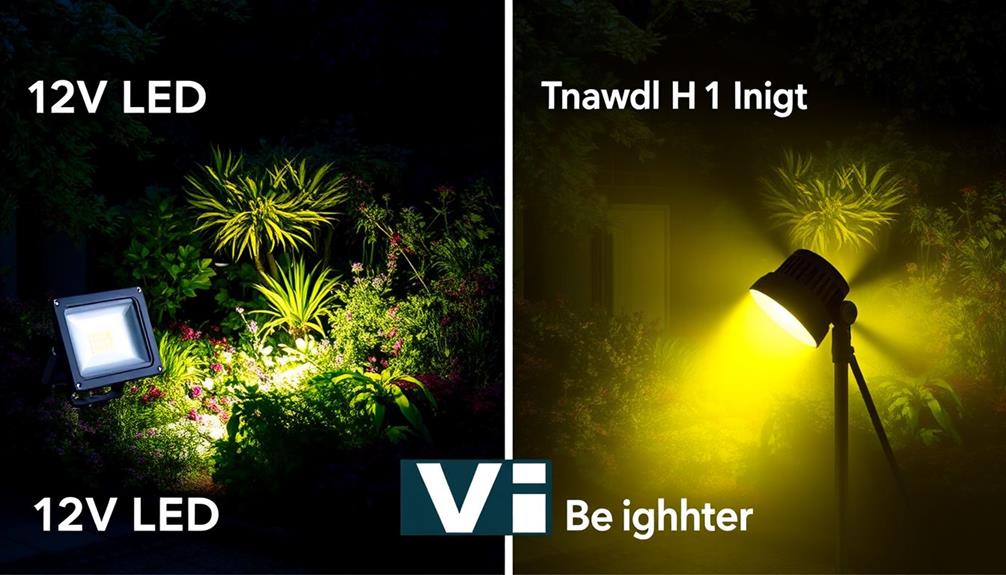
When comparing the costs between 12V LED flood lights and traditional halogen lights, you'll find that the long-term savings with LEDs are hard to ignore. While the initial costs for LED flood lights may range from $50 to $100, their energy consumption is considerably lower. Traditional halogen lights can cost you around $9.75 per month to operate, whereas LEDs might only set you back about $0.98.
This table breaks down the costs for better clarity:
| Light Type | Initial Costs | Monthly Energy Cost | Lifespan (Hours) |
|---|---|---|---|
| LED Flood Lights | $50 – $100 | $0.98 | 30,000 – 50,000 |
| Traditional Halogen | $20 – $40 | $9.75 | 2,000 – 4,000 |
Despite the higher initial investment, the total cost of ownership for LED flood lights is greatly lower due to their extended lifespan and reduced energy consumption. You'll appreciate the long-term savings and lower electricity bills that come with choosing energy-efficient lighting solutions.
Innovative Features in 12V LED Flood Lights

When you consider 12V LED flood lights, their innovative features really stand out.
These lights not only provide exceptional brightness but also integrate high-quality content boosts credibility to guarantee you make an informed choice.
You'll appreciate the energy efficiency that not only cuts down on your bills but also offers versatile installation options for any outdoor space.
Plus, advanced control features give you the flexibility to customize your lighting setup like never before.
Energy Efficiency Benefits
Energy-efficient lighting solutions, like 12V LED flood lights, offer substantial benefits over traditional halogen options.
You'll enjoy significant energy savings, consuming up to 80% less energy for the same lumen output. With a lifespan of 30,000 to 50,000 hours, these LED flood lights drastically reduce your replacement frequency and associated maintenance costs.
Here are some key energy efficiency benefits you'll appreciate:
- Energy Savings: Enjoy lower electricity bills with reduced power consumption.
- Lifespan: Lasts longer, meaning fewer replacements and less hassle.
- High Luminous Efficacy: Achieve up to 140 lumens per watt, maximizing brightness while minimizing power use.
- Maintenance Costs: Spend less on upkeep since the lights endure longer.
- Waterproof Rating: With an IP65 rating, these lights withstand outdoor environments, minimizing energy loss from weather-related issues.
Versatile Installation Options
With their versatile installation options, 12V LED flood lights seamlessly adapt to various outdoor settings, such as gardens, pathways, and architectural features.
Their low voltage operation enhances safety during installation and is perfect for any DIY enthusiast. You can customize brightness easily with adjustable wattage settings, allowing you to choose between 100W, 120W, or 150W depending on your specific lighting needs.
Many models include innovative features like motion sensors and remote control functionality, making it convenient to manage your outdoor lighting. Imagine coming home at night and having your lights turn on automatically as you approach, providing both security and ambiance.
Plus, with the IP65 waterproof rating, these lights can withstand different weather conditions, ensuring reliable performance throughout the seasons.
Whether you want to illuminate a cozy outdoor gathering spot or highlight architectural details, 12V LED flood lights offer the flexibility and durability you need for outdoor use.
Their combination of energy efficiency and versatile installation options makes them a smart choice for enhancing your outdoor spaces.
Advanced Control Features
Incorporating advanced control features, 12V LED flood lights offer an array of innovative options that enhance both convenience and security.
These cutting-edge lights not only brighten your outdoor space but also allow you to customize your lighting experience easily.
Here are some key advanced control features you'll appreciate:
- Motion Sensors: Automatically activate lights when they detect movement, boosting security while optimizing energy efficiency.
- Smart Control Capabilities: Adjust brightness and settings directly from your smartphone, giving you complete control at your fingertips.
- Dimmable Options: Modify the light intensity to suit various activities or create the perfect ambiance for your gatherings.
- Remote Control Functionality: Operate your flood lights from a distance, making it easy to manage lighting without needing to be physically present.
- Adjustable Wattage: Change power consumption (like 100W, 120W, and 150W) to meet different lighting needs while maintaining energy efficiency.
With these advanced control features, you can enjoy a more tailored, efficient, and secure outdoor lighting experience with your LED flood lights.
Frequently Asked Questions
Are LED Flood Lights More Energy-Efficient?
Yes, LED flood lights are more energy-efficient. You'll save up to 80% on energy usage compared to traditional lights. Their long lifespan means fewer replacements, leading to significant savings on your electricity bills over time.
Are LED Outdoor Lights Energy-Efficient?
When it comes to energy efficiency, you'll find LED outdoor lights shine bright. They use up to 80% less electricity, last much longer, and save you money on bills while being environmentally friendly. It's a win-win!
What Are the Disadvantages of LED Flood Lights?
You might face some disadvantages with LED flood lights, like higher initial costs, harsh color temperatures, compatibility issues with dimmers, potential flickering, and sensitivity to extreme temperatures affecting their performance in outdoor settings.
Do Outdoor Flood Lights Use a Lot of Electricity?
When you flip that switch, outdoor flood lights can gulp electricity, but not all are created equal. Traditional ones drain power, while energy-efficient options save you money and brighten your space without breaking the bank.
Conclusion
To summarize, 12V LED flood lights can transform your outdoor space while saving you money and energy. For instance, imagine installing these lights around your garden; not only do they illuminate your landscape beautifully, but they also reduce your electricity bill considerably. By choosing the right fixture and following our installation tips, you'll enjoy a well-lit, inviting area all year round. So, why not brighten up your nights with the efficiency and style of 12V LED flood lights?
As a valuable member of the Two Green Leaves team, Julia’s expertise in sustainable living and their ability to convey complex concepts in a relatable manner make them an invaluable asset. Their passion for the environment and their dedication to empowering individuals to embrace green practices make them a driving force behind our platform’s mission.
Green Living
VSUN Solar Panels: The Affordable Solar Solution You’ve Been Looking For!
Maximize your energy savings with VSUN Solar Panels; discover their unbeatable efficiency and durability that could change your energy future forever.
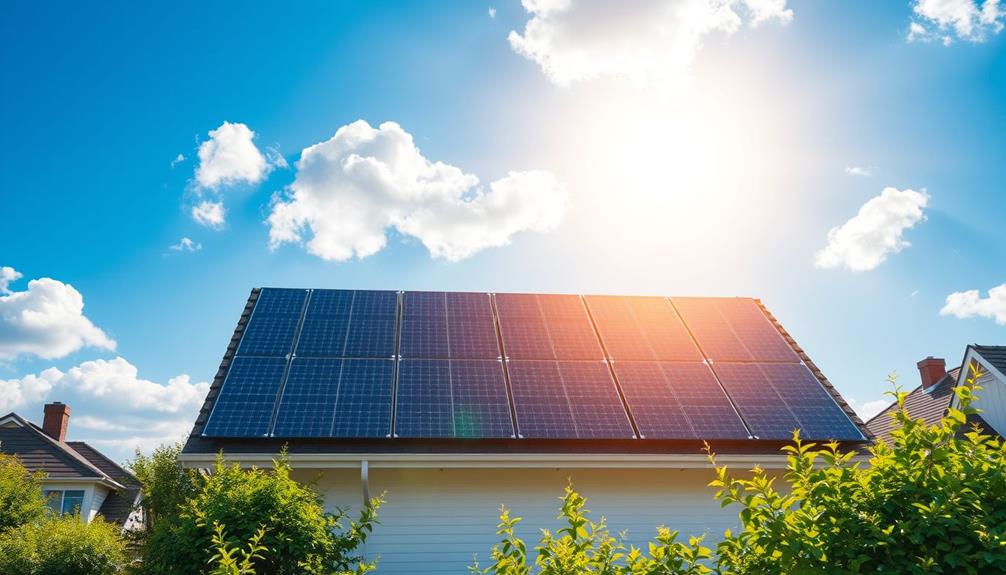
If you're searching for an affordable solar solution, VSUN Solar Panels are a great choice. With over 46 models, they offer efficiency rates exceeding 20% and durability that lasts over 25 years. The range of wattages from 310W to 550W, combined with advanced technologies like PERC and bifacial designs, guarantees you get maximum energy output. Plus, their user-friendly installation process means you can easily set them up yourself or with help. With warranties covering up to 30 years, you're making a smart investment. Want to explore the benefits in more detail? You'll uncover even more advantages ahead.
Key Takeaways
- VSUN offers a diverse range of solar panels with wattages from 310W to 550W, ensuring options for various energy needs.
- High efficiency rates exceeding 20% maximize energy production, reducing your electricity bills significantly.
- Durable construction with a lifespan over 25 years and a 25-year performance warranty ensures long-term reliability.
- Bifacial models can generate up to 30% more power, enhancing energy yield and efficiency.
- Federal and state incentives, including a 26% tax credit, make solar installation more affordable for consumers.
Company Overview
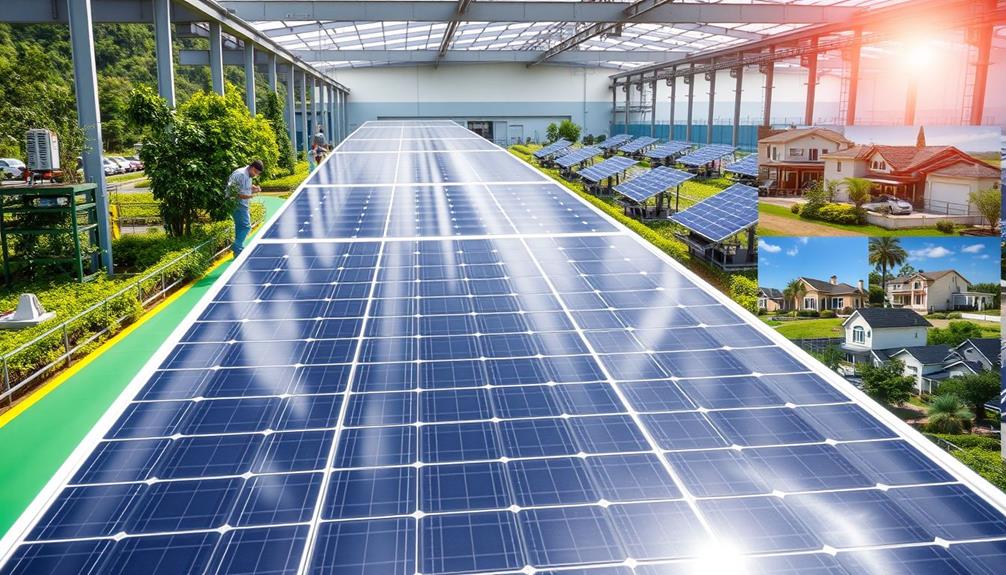
VSUN is a leading manufacturer of solar panels, offering an impressive range of 46 models across six series, with wattages from 310.0 to 550.0 watts.
You'll find that these solar panels are crafted using advanced monocrystalline and polycrystalline technology, which allows them to achieve high efficiency rates typically exceeding 20%. This means you can maximize your energy production and reduce your electricity bills effectively.
With the integration of renewable sources like solar energy, VSUN contributes to renewable energy goals, enhancing grid stability and supporting decentralized energy systems.
What sets VSUN apart is their commitment to durability and reliability. Their solar panels boast a lifespan of over 25 years, supported by a performance warranty of up to 30 years. You can trust that your investment is safeguarded for the long haul.
Additionally, VSUN adheres to international quality standards and has received certifications for performance in various weather conditions, ensuring that you'll have dependable energy generation no matter the environment.
Moreover, VSUN actively participates in sustainability projects and initiatives aimed at promoting renewable energy and reducing carbon footprints.
Product Specifications
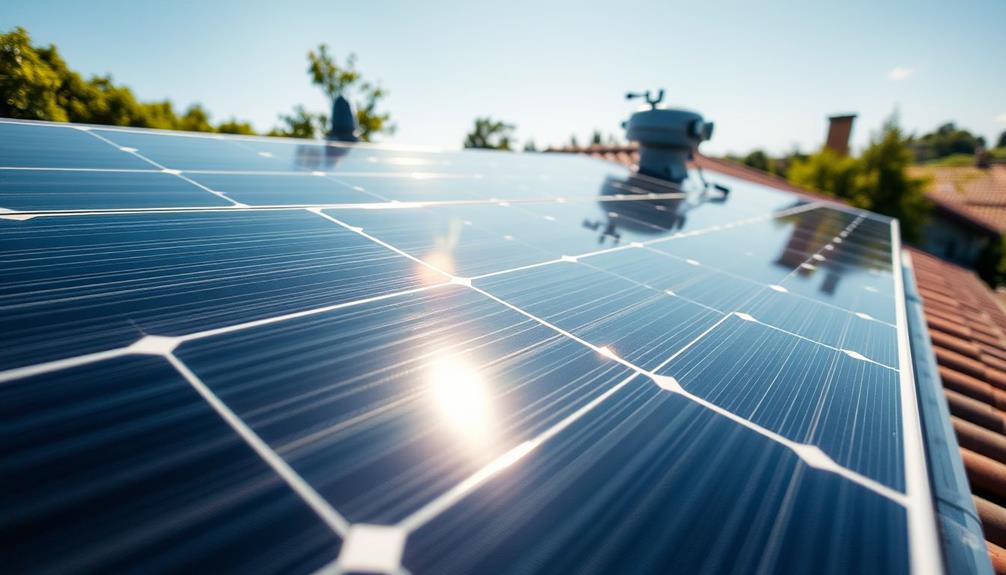
When selecting solar panels, you'll find that VSUN offers a diverse range of options to meet various energy needs. Their models cater to different preferences with polycrystalline and monocrystalline technologies, providing rated power outputs from 365W to 550W. This flexibility guarantees you can choose the right panel for your specific requirements.
The voltage specifications vary between 37.41V and 49.75V, making VSUN solar panels compatible with various systems. Designed for high performance, these panels excel even in low-light conditions, assuring you get the most energy possible, no matter the weather. Additionally, bifacial models can generate up to 30% more power, greatly boosting your energy yield.
Here's a quick overview of the product specifications:
| Model Type | Power Output | Voltage Range |
|---|---|---|
| Polycrystalline | 365W – 450W | 37.41V – 45.5V |
| Monocrystalline | 450W – 550W | 45.5V – 49.75V |
| Bifacial | Up to 30% more | Varies with model |
With robust construction and a PID-free design, VSUN solar panels promise durability and resilience against environmental factors.
Efficiency and Performance
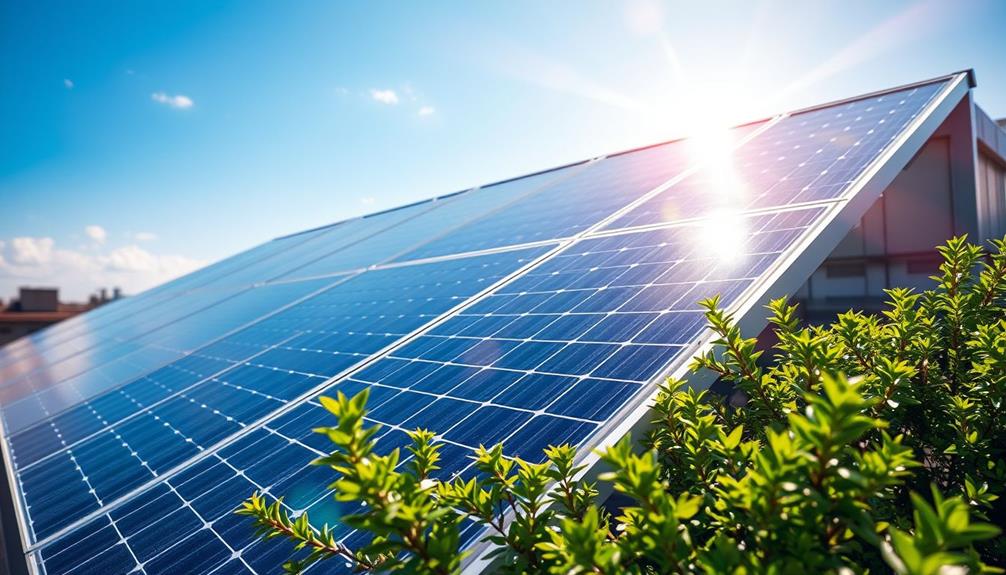
Choosing the right solar panel isn't just about specifications; it's also about how efficiently those panels perform in real-world conditions. VSUN solar panels stand out with a module efficiency of up to 21.52%, guaranteeing you get high energy output even in less-than-ideal circumstances.
Thanks to PERC (Passivated Emitter and Rear Cell) technology, these panels enhance energy capture by up to 12%, greatly boosting overall performance. Additionally, the innovative design of unique and wicked planters highlights the importance of selecting products that not only function well but also enhance your living space.
With a rated power output of 400 W, VSUN panels are designed to maximize solar energy generation, which can lead to considerable long-term savings on your energy bills. Their impressive temperature coefficient of -0.35%/°C means they maintain efficiency even in high temperatures, a vital factor if you live in a warmer climate.
Additionally, the incorporation of half-cut cell technology minimizes power loss and improves low-light performance, allowing your system to function effectively on cloudy days.
This combination of features guarantees that VSUN solar panels deliver reliable efficiency and performance, making them a smart choice for anyone looking to harness solar energy.
Installation Process
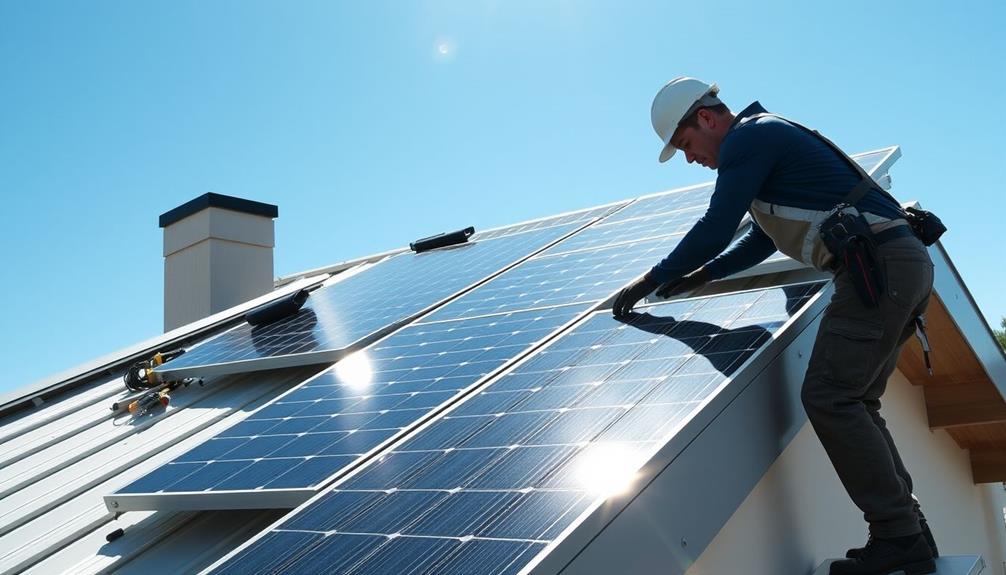
Installing VSUN solar panels is a quick and straightforward process that accommodates both certified professionals and DIY enthusiasts.
With detailed installation manuals included, you'll find it easy to follow the steps necessary for proper setup. The panels are compatible with standard mounting systems, allowing seamless integration into various roofing types, making them a great option for energy efficiency and sustainability.
Additionally, understanding power requirements for your home can enhance the overall effectiveness of your solar installation, particularly when considering smart home integration.
Here's what to expect during the installation process:
- Comprehensive manuals guide you through every step.
- Compatibility with standard mounting systems simplifies the setup.
- Professional electricians are recommended for safety and regulatory compliance.
- DIY enthusiasts can also complete the installation with proper guidance.
- Minimal maintenance is required post-installation, ensuring hassle-free solar energy benefits.
Environmental Impact
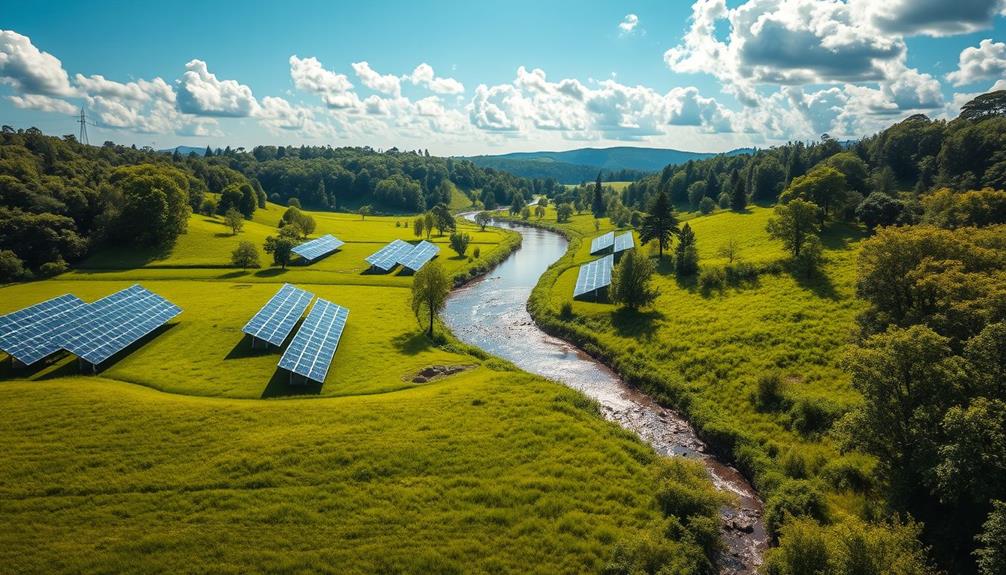
VSUN solar panels make a notable contribution to environmental sustainability by utilizing recyclable materials in their construction. This commitment to eco-friendly practices not only helps reduce waste but also greatly lowers your carbon footprint when you choose to install these panels.
In a solar panels review, you'll find that they operate efficiently across various climates, making them a reliable choice for energy independence. Additionally, investing in renewable energy solutions like VSUN panels can be part of a broader strategy to diversify your assets, similar to how one might consider a Gold IRA for long-term investments.
By opting for VSUN solar panels, you're actively reducing your reliance on fossil fuels, which promotes environmental well-being. This shift not only supports renewable energy goals but also aligns with broader sustainability initiatives.
The company's dedication to eco-friendly practices extends beyond just their products; they participate in environmental welfare projects like tree planting and promoting public transportation.
VSUN's efforts haven't gone unnoticed. In 2023, they received the Bronze Award from EcoVadis, highlighting their commitment to corporate social responsibility within the solar industry.
Choosing VSUN solar panels means you're taking a step towards a cleaner, more sustainable future, benefiting both your household and the environment.
Warranty and Support

When it comes to investing in solar panels, having a solid warranty and reliable support is vital for peace of mind. With VSUN solar panels, you get a thorough warranty package that includes a 12-year product warranty and a 25-year performance warranty, which is essential when considering the long-term financial implications of your investment long-term strategy.
This guarantees that you're covered for the long haul, providing confidence in your investment.
Here's what you can expect from VSUN's warranty and support:
- 12-year product warranty for peace of mind.
- 25-year performance warranty to guarantee output over time.
- Output warranty that varies from 12 to 40 years, depending on the panel classification.
- Open channel for customer support to address your inquiries and feedback.
- Thorough installation manuals to assist both professionals and DIY enthusiasts.
VSUN emphasizes that following installation guidelines is essential to avoid voiding your warranty.
They want to guarantee you're well-informed and supported throughout your solar journey.
With their strong commitment to warranty and customer support, you can feel secure knowing that you're making a smart, long-term investment in renewable energy.
Customer Engagement

When you choose VSUN Solar, you benefit from open communication channels that invite your questions and feedback.
This customer-centric approach aligns with the principles of design thinking, which emphasizes empathy and understanding user experiences.
Plus, you can subscribe to receive the latest news and updates about their solar products, keeping you informed.
This approach guarantees you're always engaged and connected with the brand.
Open Communication Channels
Open communication channels are essential for engaging customers effectively, and VSUN Solar Panels excels in this area. They maintain open channels for inquiries and feedback, guaranteeing you can easily reach out for support and information. This commitment to customer engagement means you're never left in the dark.
By employing effective email marketing strategies, such as targeted messaging, VSUN can keep you informed about the latest offers and updates tailored to your interests.
Here's what you can expect when interacting with VSUN:
- Quick access to customer support for immediate assistance.
- Transparent contact information readily available for inquiries.
- Feedback opportunities to share your experience and suggestions.
- Tailored marketing communications through an opt-in agreement that aligns with your interests.
- A thorough cookie policy that enhances your online experience with personalized content.
With these open channels, you can confidently engage with VSUN, knowing that your questions and concerns are addressed promptly.
Whether you need help understanding the benefits of solar energy or have specific product inquiries, VSUN guarantees you're supported every step of the way. Engaging with a company that prioritizes your needs creates a smoother, more satisfying customer experience.
Subscription for Updates
Staying updated on the latest developments in solar technology and VSUN's offerings is easy with their subscription service. By signing up, you'll receive timely updates directly in your inbox, keeping you informed about product launches, promotions, and sustainability initiatives in the world of solar energy.
This subscription guarantees you never miss out on essential information that could benefit your solar journey, including insights on cold medications overview that can help with seasonal health issues.
When you opt-in for marketing communications, you gain access to exclusive offers and insights tailored specifically to your solar energy needs. You'll get regular updates on advancements in solar technology, alongside practical tips for maximizing your energy efficiency.
This tailored approach helps you make the most of your investment in solar solutions.
Additionally, the subscription provides an open channel for your inquiries and feedback. Engaging with VSUN becomes seamless, as you can share your thoughts and questions about products or services.
With this two-way communication, you're not just a passive subscriber; you're an active participant in the VSUN community, enhancing your overall experience.
Don't miss out—subscribe today and stay connected with the future of solar energy!
Market Trends
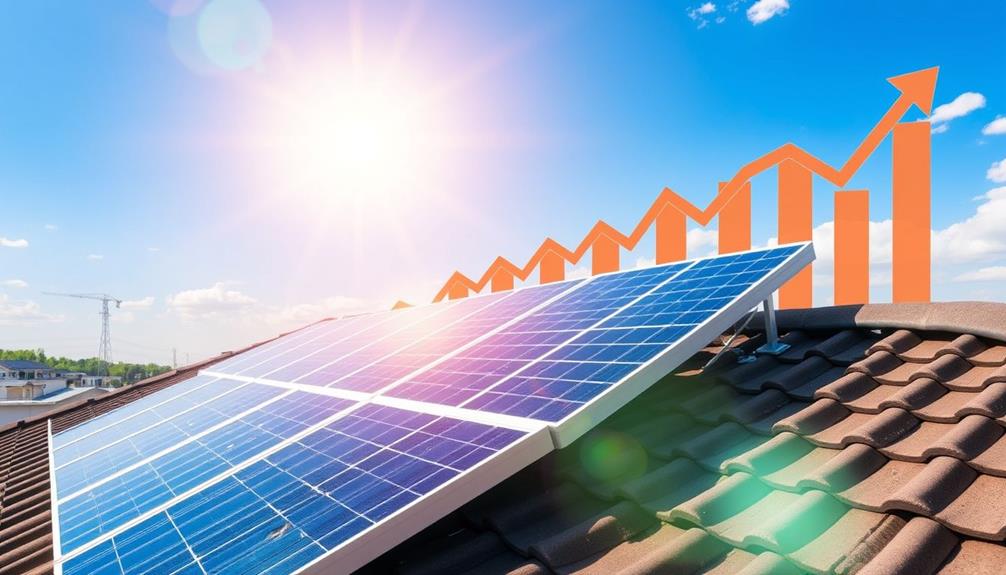
You're maneuvering a market facing challenges like a drop in solar installations and the fallout from SunPower's bankruptcy.
However, emerging solar technologies and renewable energy incentives are creating new opportunities for you as a consumer.
Additionally, understanding market trends and insights in the renewable energy sector will help you stay ahead.
Staying informed about these trends will help you make smarter decisions when considering options like VSUN panels.
Current Market Challenges
Maneuvering the current landscape of the solar panel market isn't easy, as a 20% drop in U.S. home solar installations signals potential hurdles for growth and consumer adoption in 2024.
You need to be aware of the current market challenges that are shaping the industry, especially as investors grow wary following SunPower's bankruptcy. This situation has amplified concerns about the stability of the solar market.
Additionally, similar to the challenges faced in the precious metals sector, there's a growing need for transparent fee structures in solar investments to build consumer trust.
When looking for solar panel options, consider these key issues:
- Increased focus on high-efficiency solar products to stay competitive.
- Supply chain disruptions that affect the availability of materials.
- Rising costs that impact pricing for consumers.
- Consumer hesitance due to market instability.
- The importance of informed decisions, supported by resources like the EnergySage Buyers Guide.
Navigating these challenges is vital for making smart investments in solar technology.
As you explore your options, remember that understanding these market dynamics can empower you to choose the best solutions for your energy needs.
Emerging Solar Technologies
As the solar panel market evolves, new technologies are emerging that can greatly enhance energy efficiency and performance. One such innovation is PERC (Passivated Emitter and Rear Cell) technology, which boosts energy capture by up to 12%. This means you'll get more power from the same amount of sunlight, making your investment even more worthwhile.
Another promising advancement is half-cut cell technology, which reduces power loss and improves low-light performance, optimizing energy generation in various climates.
If you're looking for even greater efficiency, bifacial solar panels are becoming increasingly popular. These panels can capture sunlight on both sides, generating up to 30% additional power.
Moreover, the integration of smart home technology with solar systems is on the rise. This allows you to monitor and manage your energy usage more effectively, maximizing the return on your solar investment.
With a significant shift toward sustainability in the market, companies are also focusing on eco-friendly materials and manufacturing practices.
Renewable Energy Incentives
Numerous renewable energy incentives are transforming the solar market, making solar installations more affordable and appealing for homeowners.
These incentives markedly lower the overall costs, allowing you to enjoy substantial financial savings while contributing to a greener planet.
Here are some key incentives you can take advantage of:
- Federal Solar Tax Credit: Deduct 26% of your solar panel installation costs from your federal taxes.
- State Incentives: Many states offer additional rebates and credits for solar adoption.
- Performance-Based Incentives (PBIs): Get paid for the energy your solar system produces.
- Net Metering: Receive credits for any excess electricity your panels generate, reducing your utility bills.
- Local Grants and Financing: Access programs that lower upfront costs, making solar energy more accessible.
Purchasing Benefits

When you choose to invest in VSUN Solar panels, you're not just getting top-tier solar technology; you're also reaping the benefits of a streamlined purchasing process.
With warehouses located on both the East and West coasts of the USA, you can enjoy quick access to high-quality solar panels, no matter where you are.
VSUN guarantees that your orders are processed within 24 hours and shipped within 48 hours, ensuring swift delivery. You can expect your solar panels to arrive at your doorstep within just 4-7 business days, thanks to efficient freight transport. This means you won't have to wait long to start enjoying the benefits of renewable energy.
Moreover, all VSUN Solar panels are made from A-grade equipment sourced from verified manufacturers. This commitment to high quality guarantees that you receive reliable products that won't let you down.
Plus, there's a guarantee of no counterfeit products in inventory, so you can invest with confidence.
Frequently Asked Questions
Who Makes VSUN Solar Panels?
You'll find that VSUN Solar Panels are manufactured by a company specializing in solar technology. They focus on high efficiency and durability, ensuring their panels meet international quality standards for reliability and performance.
What Is the Biggest Drawback of Solar Panels?
The biggest drawback of solar panels is the initial installation cost, which can range between $15,000 and $25,000. Additionally, efficiency can decline over time and in less sunny conditions, impacting your long-term savings.
What Is the Capacity of Vsun?
The capacity of VSUN solar panels ranges from 310 to 550 watts, with maximum outputs typically between 250W and 400W. You can choose based on your energy needs and installation preferences.
Who Makes the Most Cost Effective Solar Panels?
When searching for cost-effective solar panels, consider brands known for competitive pricing and high efficiency. You'll find options that balance affordability with performance, ensuring you get the best value for your investment in renewable energy.
Conclusion
In a world where the sun shines brightly on your savings, Vsun solar panels stand as your trusty companion in the journey toward sustainable energy. With their affordable pricing and impressive performance, you're not just buying panels; you're investing in a greener future. So, why wait? Embrace the sunlight, cut those energy bills, and watch your eco-friendly dreams take flight. With Vsun, you're not just making a choice; you're lighting the way for a brighter tomorrow!
As a valuable member of the Two Green Leaves team, Julia’s expertise in sustainable living and their ability to convey complex concepts in a relatable manner make them an invaluable asset. Their passion for the environment and their dedication to empowering individuals to embrace green practices make them a driving force behind our platform’s mission.
Green Living
Solar Post Cap: The Stylish Way to Light Up Your Fence or Deck!
A stylish solar post cap can transform your outdoor space, but discover the innovative features that make them a must-have for your home!
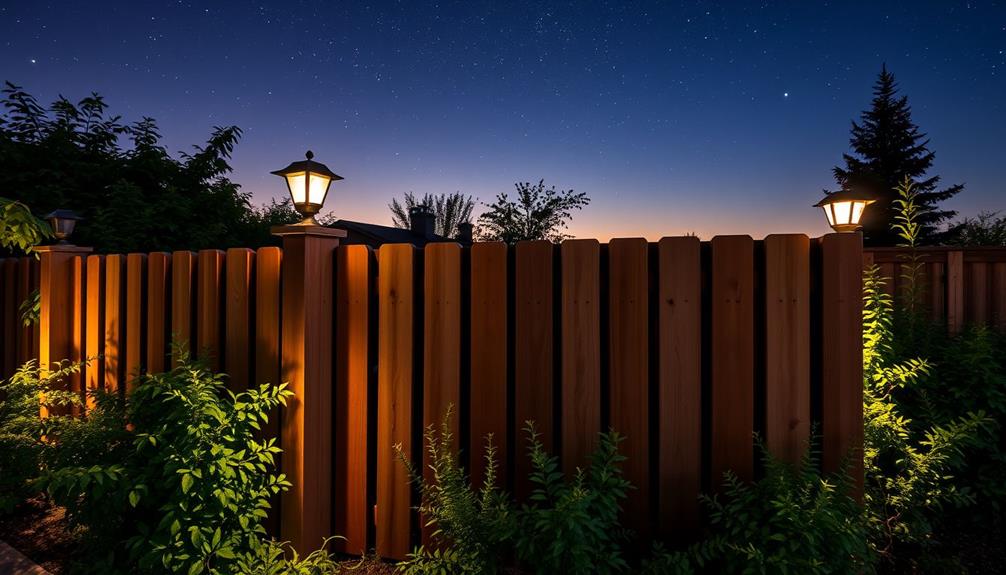
Solar post caps are a stylish way to light up your fence or deck, blending safety with elegance. These eco-friendly lights charge fully during the day and shine for up to 12 hours at night, making your outdoor spaces inviting. With designs ranging from lamp styles to minimalist band styles, you'll find the perfect fit for your aesthetic. Plus, installation is a breeze—no wiring required! They're durable and weather-resistant, ensuring long-lasting beauty. If you're curious about different styles, pricing options, or the latest innovations, you won't want to miss what's next!
Key Takeaways
- Solar post caps enhance the aesthetic appeal of fences and decks while providing functional outdoor lighting.
- They operate for up to 12 hours on a full charge, ensuring visibility at night.
- Available in various styles like lamp, band, and downward lighting to fit different design preferences.
- Easy installation requires no wiring, making them user-friendly and convenient for homeowners.
- Durable and weather-resistant materials ensure longevity, making them a reliable choice for outdoor spaces.
Benefits of Solar Post Caps

Solar post caps transform your outdoor spaces by providing both aesthetic appeal and functional lighting. These innovative fixtures deliver ambient lighting that enhances visibility for your decks and fences. With a full charge, they can operate for up to 12 hours, ensuring your pathways are well-lit throughout the night.
Additionally, using solar energy for lighting is an eco-friendly choice that complements sustainable practices, similar to energy savings from solar pool covers.
You'll love the average brightness output of 5 to 15 lumens, which effectively illuminates your outdoor areas while promoting safety without the hassle of wiring or electricity. Made from durable materials, solar post caps are built to withstand various weather conditions, meaning they'll last through rain, snow, and sun without losing performance.
One of the best features is how easy to install they are. You won't need professional help; simply place them in areas that receive ample sunlight for ideal charging.
Plus, many models come with customizable light color options, allowing you to switch between warm and cool light to create the perfect ambiance in your outdoor spaces. With all these benefits, solar post caps are a smart choice for anyone looking to enhance their yard while enjoying hassle-free, stylish lighting.
Popular Styles and Designs
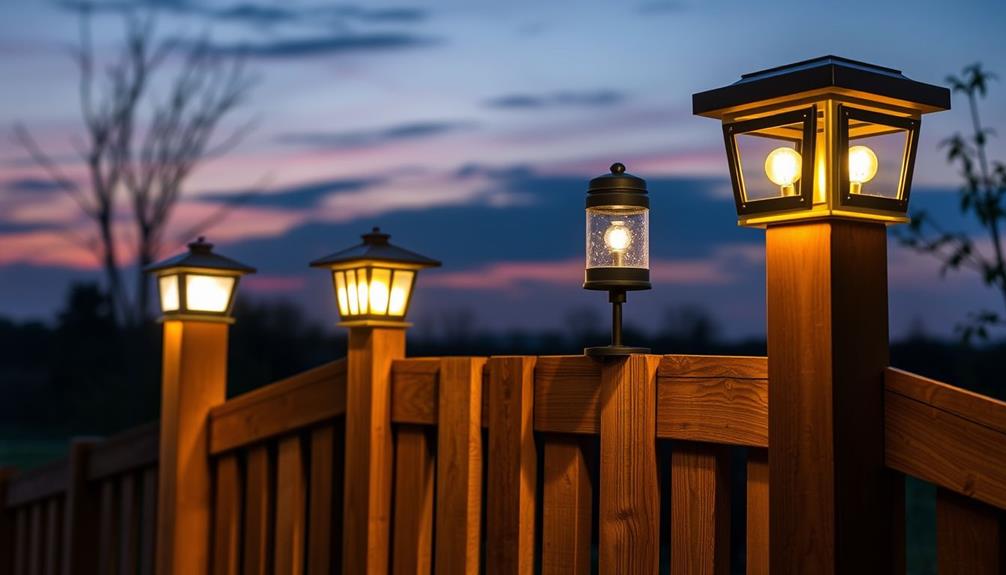
When you choose solar post caps, you'll find a range of styles that not only enhance the aesthetics of your outdoor space but also provide versatile lighting options.
By fostering creativity and innovation in your choices, you can create an inviting atmosphere that reflects your personal style and values, much like the principles of design thinking.
From the elegant lamp designs to minimalist band styles, there's something for every taste.
Plus, with easy installation features, upgrading your outdoor lighting has never been simpler.
Aesthetic Enhancement Options
Enhancing the aesthetic appeal of your outdoor space is easy with the right solar post caps. These stylish solar post cap lights come in an extensive range of designs, allowing you to choose the perfect fit for your taste.
Popular models like Fairmont, Colonial, and Ambience cater to various aesthetics, from traditional to contemporary. Additionally, integrating natural elements like plants and water features can complement your outdoor lighting design, creating a harmonious environment DIY Fire Pit Ideas.
If you're after significant illumination, the lamp style post caps with glass panel sides are ideal. They not only light up your outdoor areas but also add a touch of elegance.
For a more minimalist approach, consider band-style caps that provide ambient lighting without overwhelming your design.
If safety is a priority, downward lighting caps are a great option. They enhance visibility on walkways and decks, making your outdoor spaces both functional and visually appealing.
With prices ranging from $15.99 to $99.99, you'll find high-quality solar post caps that suit different budgets and design preferences.
Versatile Lighting Styles
Choosing the right lighting style for your outdoor space can transform its ambiance and functionality. With solar post caps, you can easily enhance your fence or deck while enjoying versatile lighting styles that suit your needs.
Here's a quick overview of popular solar post cap styles:
| Style | Features | Best For |
|---|---|---|
| Lamp | Glass panel sides, directs light | Illuminating walkways & spaces |
| Band | Minimalist design, central band | Ambient lighting, subtle effects |
| Downward | Focuses light below | Safety for decks & walkways |
Classy Caps offers a range of options in various finishes and sizes, ensuring they complement any outdoor decor effortlessly. The lamp style gives you bright, directed light, while the band style creates a warm, inviting atmosphere without overwhelming brightness. If safety's your priority, the downward style provides effective illumination right where you need it.
Easy Installation Features
Installing solar post caps is a breeze, thanks to their user-friendly design. With no wiring required, you can simply place these stylish fixtures on top of your existing fence or deck posts. Most models include screws and clear instructions, making the setup process straightforward, even if you don't have much DIY experience.
Additionally, investing in solar lighting can be a smart choice for enhancing your outdoor space while keeping energy costs low, as these products utilize renewable energy sources, aligning with a sustainable lifestyle. You can explore more about common financial terms related to home improvement investments.
These solar post caps fit a variety of post sizes, including popular dimensions like 4×4 and 6×6, ensuring compatibility with common fencing and decking structures. You won't have to worry about finding the perfect fit; these caps are designed to accommodate your needs with ease.
In addition to their easy installation, many styles, such as lamp and band designs, bring both aesthetic appeal and functional lighting to your outdoor spaces. You can effortlessly enhance your yard while enjoying the benefits of ambient lighting.
Moreover, constructed from weather-resistant materials, these solar post caps are built to last, allowing you to enjoy them without frequent maintenance or replacements. With their combination of easy installation and durability, solar post caps are the perfect choice for anyone looking to elevate their outdoor aesthetics.
Installation and Maintenance Tips
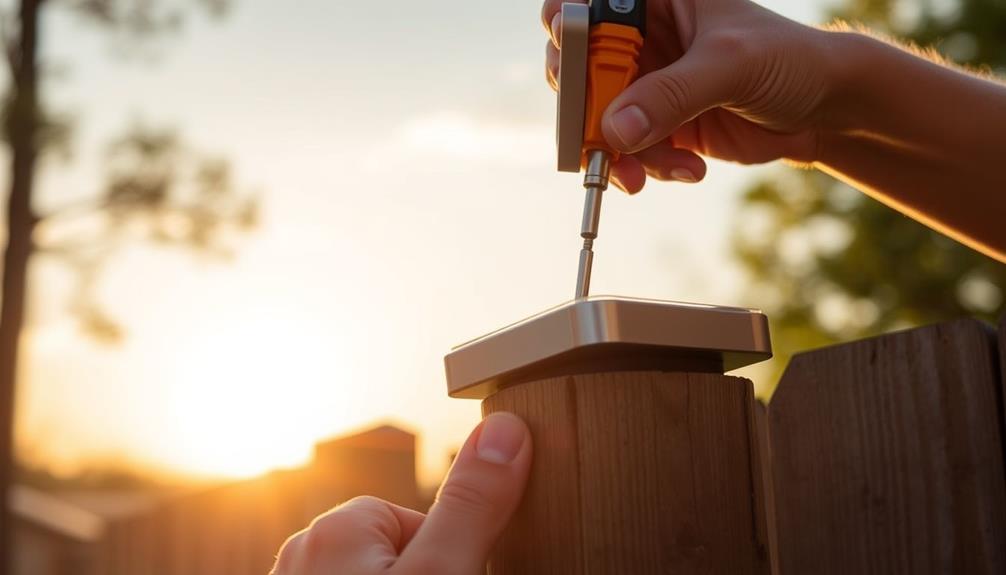
When it comes to installing solar post caps, accurate measurements are essential for a proper fit, so be certain to measure your posts from outside to outside. Knowing whether you need 4×4 or 6×6 sizes will save you time and hassle.
Additionally, confirming that your installation aligns with advanced technology for enhanced temperature regulation can contribute to a more efficient overall setup. The installation process is straightforward; just follow the included instructions and use the provided screws. You won't need professional help, making it a perfect DIY project.
For effective maintenance, regularly clean the solar panels to guarantee peak performance. Dirt and debris can hinder sunlight absorption, reducing the efficiency of your solar lights.
Seasonal checks are also important; inspect the functionality of the lights and replace batteries if necessary. Over time, battery replacement may be required, especially after several years of use.
To maximize the benefits of your solar post caps, install them in areas that receive ample sunlight during the day. This will allow them to charge effectively, providing up to 12 hours of illumination at night.
Pricing and Warranty Information
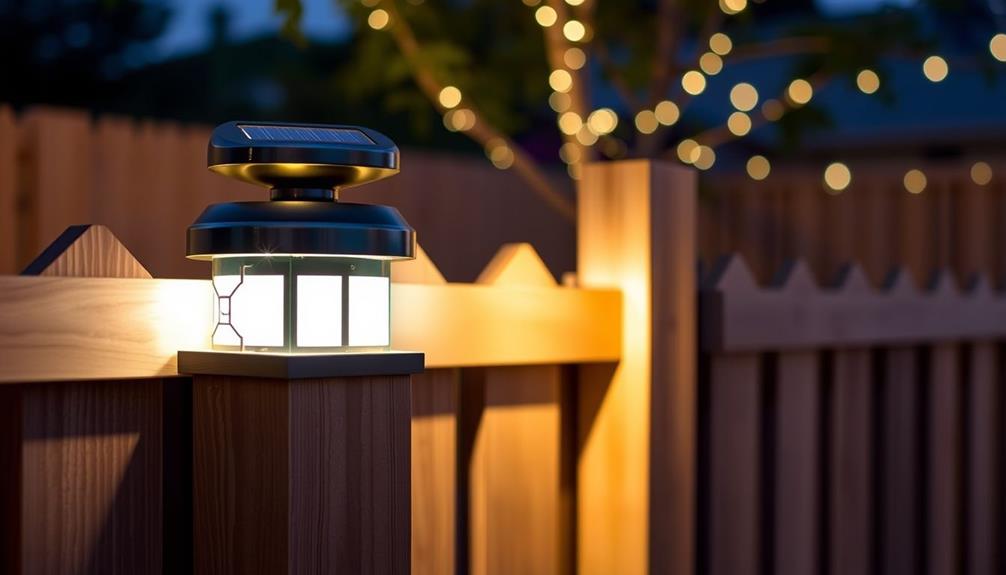
Solar post caps offer a range of pricing options to fit different budgets, starting as low as $15.99 and going up to $99.99.
This flexibility means you can find a stylish outdoor lighting solution without breaking the bank. Depending on your needs, you can choose from various models that not only enhance your fence or deck but also fit your financial plan.
If you're looking for high-quality investment options, consider exploring the benefits of Gold IRA offerings for a secure financial future.
Many solar post caps come with a warranty option, providing you with added confidence regarding their quality and longevity.
This warranty guarantees that you're making a sound investment, and it reflects the manufacturers' confidence in their products.
If you're thinking about a larger project, consider taking advantage of volume discounts.
You can enjoy savings of 10%, 15%, or even 20% on bulk purchases starting at three sets. Plus, free shipping on all orders makes it even more convenient for you to receive your solar post caps without extra costs.
With positive average customer ratings across various models, you can feel assured that you're choosing a reliable product that meets your expectations for quality and durability.
Customer Reviews and Feedback
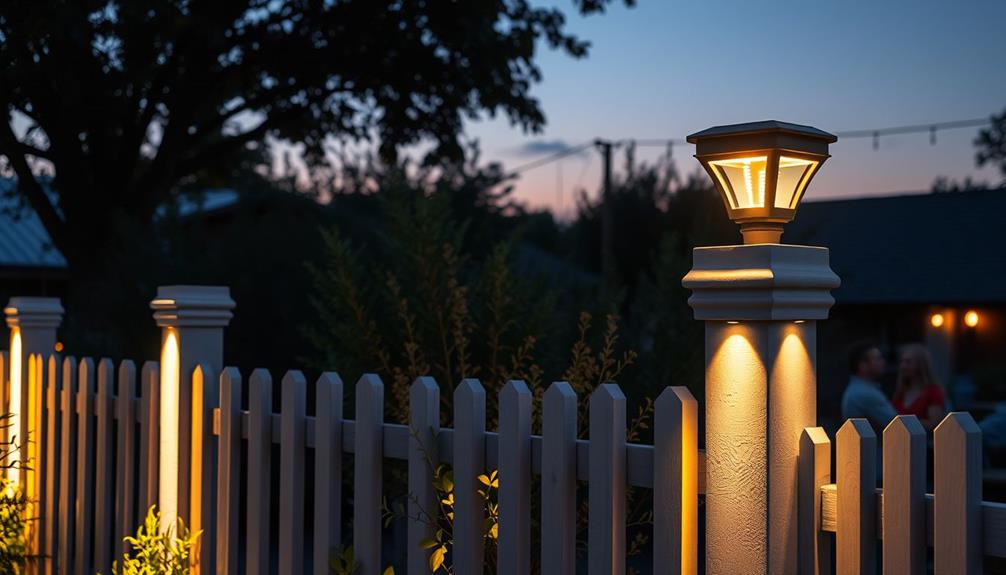
When it comes to the JOFIOS Solar Post Cap Lights, customers often highlight their impressive quality and durability.
Many users find the installation process straightforward and quick, making it easy to enhance their outdoor spaces.
These lights also provide a stylish touch that can complement various home designs, similar to how the best vacuums for dust removal in 2024 are tailored to meet specific cleaning needs.
Additionally, the adjustable lighting options add a personal touch, fitting various moods and occasions.
Quality and Durability Insights
Highlighting the quality and durability of solar post caps, customer reviews consistently reflect a high level of satisfaction. With an average rating of 4.4 out of 5 stars from 822 reviews, it's clear that many appreciate both the aesthetic appeal and the reliability of these products.
Additionally, these solar post caps can be an excellent choice for enhancing outdoor spaces, much like the family-friendly amenities found at various water park hotels.
Here's what you can expect:
- Weather-Resistant Design: Many customers rave about the durability, noting that the solar post caps withstand harsh weather conditions, including heavy rain, wind, and snow.
- Quality Materials: Users frequently mention the solid construction, which contributes to the longevity of the post caps.
- Easy Installation: The majority appreciate the straightforward installation process, thanks to clear instructions and included hardware that make setup hassle-free.
- Satisfaction Guarantee: The 30-day return policy through Amazon enhances confidence in the quality and reliability of the solar post caps, assuring customers they're making a wise investment.
While a few reviews mention occasional defects, most users are pleased with their purchase, highlighting the consistent performance that these solar post caps deliver.
Installation Experience Highlights
Many customers appreciate how easy the installation process is for solar post caps, often managing to set them up without hiring a professional. With straightforward instructions and all necessary hardware included, you can quickly enhance your outdoor space.
Here's what users say about their installation experience:
| Feature | Customer Feedback |
|---|---|
| Installation Ease | "I installed them in less than an hour!" |
| Aesthetic Appeal | "They look fantastic on my fence!" |
| Automatic Lighting | "Love how they turn on by themselves!" |
Many users enjoy switching between warm and cool light modes, which adds to the ambiance of their decks and fences. The solar post caps are also praised for their durability, standing up to various weather conditions while still functioning perfectly. This combination of aesthetic appeal and practicality makes these caps a favorite among homeowners. The automatic lighting feature, which activates at night after a day of charging in sunlight, is often highlighted as a convenient addition to their outdoor spaces. Overall, the installation experience leaves customers satisfied and excited about their new solar post caps.
New Product Releases and Innovations
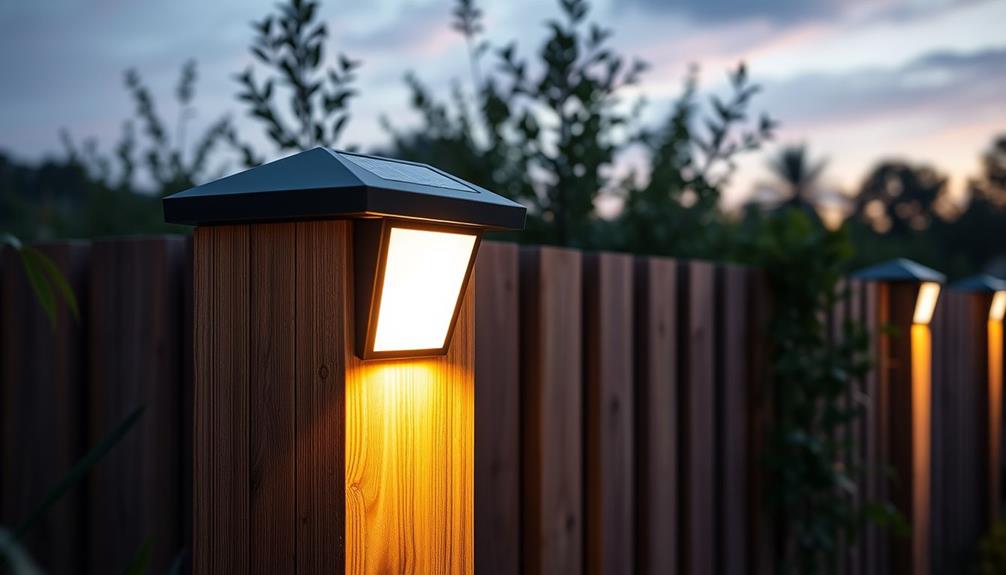
Discover the latest innovations in solar post caps, where technology meets outdoor elegance. With the rise of advanced materials in solar technology, you'll be thrilled to explore these new product releases that enhance your outdoor lighting experience while prioritizing energy efficiency.
- Lumineer Smart Solar Post Cap: Control your outdoor ambiance with your smartphone, adjusting color, brightness, and duration to suit any occasion.
- Black Stainless Steel Deck & Wall Light: This contemporary design not only elevates modern aesthetics but also provides efficient illumination for your spaces.
- Dual Light Color Options: Switch effortlessly between warm and cool white modes to create the perfect mood for any gathering or relaxation time.
- 4×4 Aluminum Post Cap: Combining versatility and durability, this innovative design is built to withstand various weather conditions, ensuring long-lasting performance.
With these advancements in innovative technology, solar post caps are becoming more functional and stylish than ever.
You'll appreciate how these enhancements not only beautify your outdoor spaces but also help you save on energy costs, making your home more environmentally friendly.
Upgrade your outdoor lighting with these exciting new options today!
Frequently Asked Questions
Do Solar Fence Post Caps Work?
Yes, solar fence post caps work effectively. They harness solar energy during the day, lighting up your outdoor spaces at night. With minimal maintenance and easy installation, they're an excellent choice for illumination.
How Long Do Solar Fence Post Caps Last?
Solar fence post caps typically last between 10 to 20 years, depending on their materials and usage. By keeping the solar panels clean, you can enhance their performance and lifespan considerably. Regular maintenance helps too.
Are Solar Post Lights Worth It?
Imagine a moonlit garden, where shadows dance and paths glow softly. Solar post lights are definitely worth it; they offer easy installation, eco-friendly lighting, and lasting beauty, transforming your outdoor space into a nightly oasis.
How Do You Install Deck Post Cap Lights?
To install deck post cap lights, measure your posts, attach the lights securely with screws, and guarantee they're placed in sunlight for proper charging. Check regularly for dirt on solar panels to maintain performance.
Conclusion
In a world where your fence or deck deserves to shine, solar post caps are the twinkling stars that light up your outdoor space. Not only do they enhance your home's style, but they also bring eco-friendly charm to your evenings. With easy installation and a variety of designs, these luminous accents are a breeze to maintain. So why let your space linger in the shadows? Embrace the glow and let your outdoor areas dazzle!
As a valuable member of the Two Green Leaves team, Julia’s expertise in sustainable living and their ability to convey complex concepts in a relatable manner make them an invaluable asset. Their passion for the environment and their dedication to empowering individuals to embrace green practices make them a driving force behind our platform’s mission.
-
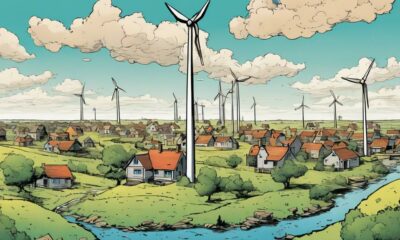
 Green Living3 months ago
Green Living3 months agoHow Many Homes Can a Wind Turbine Power?
-
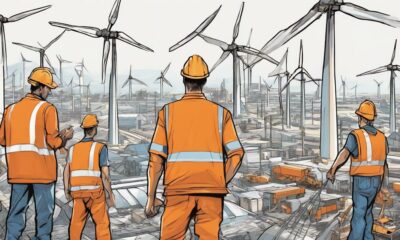
 Green Living3 months ago
Green Living3 months agoHow Do They Assemble a Wind Turbine?
-
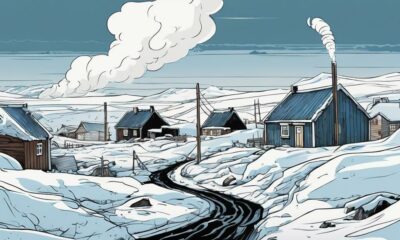
 Green Living3 months ago
Green Living3 months agoWhat Percent of Homes in Iceland Are Heated by Geothermal Energy?
-
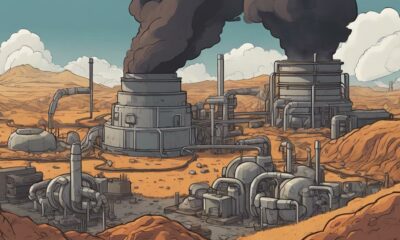
 Green Living3 months ago
Green Living3 months agoHow to Get Geothermal Energy in RimWorld
-
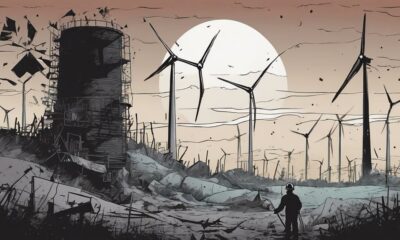
 Green Living3 months ago
Green Living3 months agoEngineers Who Died on Wind Turbines: A Memorial
-

 Green Living3 months ago
Green Living3 months agoHow Is Electricity Made From Geothermal Energy?
-

 Green Living3 months ago
Green Living3 months agoWhat Would Happen If Geothermal Energy Ceased to Exist?
-

 Green Living3 months ago
Green Living3 months agoHow Can Geothermal Energy Be Used to Make Electricity?






